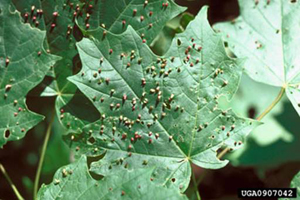DACF Home → Bureaus & Programs → Maine Forest Service → Forest Health & Monitoring → Forest Pest Index → Maple Bladdergall Midge
MAPLE BLADDERGALL MITE
Vasates quadripedes (Shimer)
Symptoms and Damage
In late spring, owners of silver maples may note that certain leaves on their trees are covered with clusters of small warty, greenish or pink lumps or growths known as galls. Such galls may be abundant from mid-June to early July when they become rose-colored and later black. Abundance of galls varies from year to year. Red maple and sugar maple may also be affected but usually to a lesser degree.
The galls are formed as the result of feeding on the very young leaves by tiny mites which cause an irritation to the surface of the leaf, and results in a pouch-like gall. Inside the gall is a cavity which contains one or more mites. The mites feed on the leaf inside the cavity and are protected by the gall.
Injury to the tree is not considered serious, although the galls give an unsightly appearance to a tree if abundant.
Hosts
Silver maple, red maple, and sugar maple

Photo: Ronald S. Kelley, Vermont Department of Forests, Parks and Recreation, Bugwood.org
Life History and Habits
The mites overwinter as adults under bark scales. In the spring the mites move to the opening buds where they feed on the undersurface of unfolding leaves. The feeding causes the formation of a depression that eventually becomes a pouch-like gall 2-3 mm in diameter, within which the enclosed mite continues to feed and lay eggs. The eggs hatch in about a week, and the young-developing nymphs continue to feed until fully grown. Mature mites leave the galls and infest new foliage.
Control*
The mites must be sprayed before they become encased within the protective galls. Affected silver maples should be sprayed with oxythoquinox or carbaryl or other pesticides labeled for it on a warm day in the spring (April) as the leaf buds are swelling. This time coincides with flower parts on the trees being fully developed or just past this stage. Dilute the miticide according to label directions. Dormant oil is also both registered for control of bladdergall mites. However, oil has the potential to cause foliar injury if applied immediately following budbreak.
*NOTE: These recommendations are not a substitute for pesticide labeling. Read the label before applying any pesticide. Pesticide recommendations are contingent on continued EPA and Maine Board of Pesticides Control registration and are subject to change.
Caution : For your own protection and that of the environment, apply the pesticide only in strict accordance with label directions and precautions.
MAINE DEPARTMENT OF AGRICULTURE, CONSERVATION AND FORESTRY
Maine Forest Service - Forest Health and Monitoring Division
April 2000